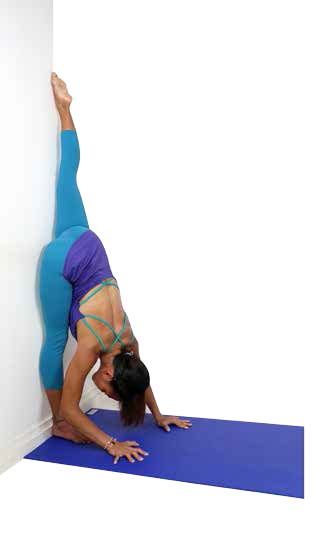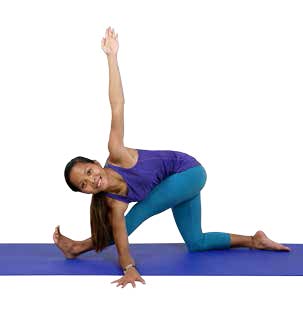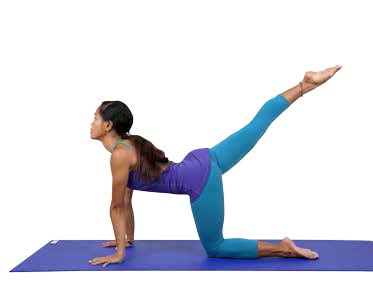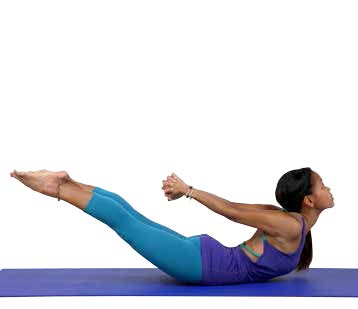By Louise Vas (Instagram @wyswys), with the guidance of Yogananth Andiappan
Poses demonstrated by Esti Puji
This month’s featured pose is extra special as it is demonstrated by Esti Puji, a domestic worker in Hong Kong who has started her yoga journey with the Andiappan Yoga Community (AYC). AYC is based in Hong Kong and has programs in both Hong Kong and India, with the aim of bringing yoga to all and enrich lives with yoga. After years of dedicated practice, Esti is now sharing her yoga journey with Asana Journal by demonstrating the poses for this article.
This month’s post is an intermediate variation of Hanumanasa or pose dedicated to Lord Hanuman.

WARM – UP
The below warm-up poses are recommended to prepare the body for different movements needed to achieve the final pose.

Parsvottanasana / Pyramid Pose
1. From Tadasana or standing straight, step the right foot forward.
2. The front foot points forward while the back foot can be slightly turned outwards. For experienced practitioners, the back foot can point forward as piscina gonfiabile con scivolo well. Keep both legs straight.
3. Square the hips and hold the waist. Lengthen the torso by lifting the chest and roll the shoulders back.
4. Inhale and on exhale, bend forward from the hips, reaching the hands down to the floor. Keep the arms straight and look forward to keep the back neutral.
5. Hold the pose for a few breaths and slowly come out of the pose by bending the front knee and pressing the foot to push the body up.
6. Repeat the same with the left leg forward.
Benefit: Stretches the hamstrings and lengthens the spine.

Parivrtta Trikonasana / Revolved Triangle Pose
1. From Parsvottanasana with the right leg in front, bring the left hand to the outside of the right foot.
2. Slowly turn the torso to face the right and on exhale, extend the right arm up.
3. Pull the right shoulder back and keep the chest open.
4. Look to the right or if balance is not a challenge, look up towards the right arm.
Benefit: Lengthens the oblique muscles for twisting while stretching the hamstrings.

Seated Twist
1. Sit on the floor with the legs extended and apart. Engage the calf muscles by flexing the ankles and pointing the toes up.
2. Extend the spine. Inhale and on exhale, twist to the right, bring the hands to the floor and look down.
3. Keep the hips grounded and bend the elbows to deepen the twist. Stay for a few light breaths.
4. Press the palms to come out of the pose and do the twist towards the left side.
Benefit: Improves the rotation of the spine.

Internal Shoulder Rotation
1. Sit on the floor with the knees bent and legs apart.
2. Bring the hands together in front of the chest, with the elbows pressing against the thighs.
3. Inhale and on exhale, squeeze the legs and allow the chest to move inwards, slowly rounding the back and feeling the stretch to the shoulders.
4. Bring the chin down and exhale fully.
5. Breathe lightly while in the pose and slowly release. Repeat the stretch two more times.
Benefit: Stretches the deltoids and improves internal/medial rotation of the shoulders.

Banarasana / Lunge variation – quadriceps stretch
1. Come into a low lunge position with the right leg forward; the right hand is resting on the thigh.
2. Bend the left knee and with the left hand, reach for the top of the foot from behind. Rotate the left shoulder outwards to keep a good grip on the foot, with the elbow pulled in and the fingers pointing forward.
3. Inhale and on exhale, bring the left heel closer to the left buttocks. Raise the torso and keep the spine lifted.
4. Hold the pose for a few deep breaths. Slowly release the pose and repeat on the other side.
Benefit: Lengthens the quadriceps and improves hip extension movement.

Parivrtta Kapotasana / Revolved Pigeon Pose
1. From the lunge position with the right leg forward and hands on the floor, drop the right knee sideways, next to the right arm. Have the shin to be aligned horizontally.
2. Tuck the left toes and pull the body backwards; stretch and straighten the left leg back.
3. Slowly sink the hips down and keep the body weight in the centre. Shift the weight to the left side to square the hips.
4. Twist to the right side and bring the left shoulder to the floor, in front of the right shin.
5. Inhale and on exhale, raise the right arm and bring the arm back to deepen the twist. Keep the chest open and shoulders broad.
Benefit: Improves hip flexion movement and stretches the lower back for better twisting.
Eligibility Pose
Practice the below to have a better understanding of the muscles involved in the final pose

Hanumanasana / Monkey Pose or Lord Hanuman’s Pose
A regular practice of Hanumanasana allows the body to adapt to this deep hamstring stretch needed for the final pose. Practice by keeping the body upright aiming to become comfortable in this pose before trying the revolved variation.
Steps

1. Stand on the knees with the knees and feet hip-width apart.

2. Place the hands on the floor with the arms shoulderwidth apart, and keep the back neutral.

3. Extend the left leg forward with the heel on the floor and toes pointing up.

4. Keep the weight on the hands; slowly extend the front leg to lower the body. To avoid resting the weight on the left side, use the back leg by tucking the toes and pulling the body back to lower the body gradually. Lean towards the right side and aim to have the right front side of the hip to face the floor.

5. Raise the right arm and extend the spine; twist the body to the left and place the elbow on the outer side of the left knee. Press the palms together and move the thumbs close to the chest.
Final Pose
Pull the left shoulder back to deepen the twist.

Flex the ankle of the left foot and keep the gaze towards the left side.
VARIATION
There are many ways an asana can be performed or interpreted depending on each practitioner, and classic Hatha Yoga text suggests that there are over 8 Million poses.

From Hanumanasana with the left leg in front, reach the right arm forward and come into a forward bend. Use both hands to hold the left foot and keep the shoulder broad.
From Step 4, raise the right arm, extend the spine and twist to the left. Place the right hand on the floor, in line with the knee and aim to lower the right shoulder. Extend the left arm up and keep the twist for a few light breaths.
MODIFICATIONS
The below modifications are available:
Hanumanasana (Wall Support variation)

Stand close to the wall with both heels against the wall. Bend forward and place the hands on the floor. Shift the weight forward to make space between the hips and the wall. Bend the left knee and slowly extend the leg towards the wall, straightening the leg gradually. Aim to have the left thigh on the wall. Move the hands closer to the right leg and keep the forward bend. Stay with eyes open and normalize the breath.
Parivrtta Ardha Hanumanasana / Revolved half-split Variation

For those with limited hamstring stretch
From Step 3, simply place the right hand outside of the left leg and twist the body. Lower the right shoulder to be close to the left knee. Keep the balance on the right knee and when ready, extend the left arm up and back to keep the chest open and shoulders broad.
Neutralizing movements
Neutralizing movements are important for long-term injury prevention; it allows the body to return to its neutral position. Be aware of pressure alert points and listen to your body – do neutralizing movements after slowly coming out of the pose.
Balasana / Child’s Pose

From Vajrasana or Diamond pose, separate the knees and bring the body into a forward bend, extending the arms in front. As gravity works, let the chest and forehead or chin rest on the floor and the whole body relaxing into the pose. Stay for few breaths and release the pose.
Counter poses
The below counter poses help in relieving any tension created in the wrists, hips and torso.
Vyagrasana / Tiger Pose

With the hands and knees on the floor and the back in its neutral shape, lift and straighten the right leg above hip level, pointing the toes. Press the palms on the floor and arch the back; raise the chin and look up. Hold for a few regular breaths; bring the right knee to the floor and repeat the pose on the opposite side.
Salabasana / Locust Pose variation

Lie down with the abdomen on the floor and interlock the fingers at the back. Inhale and on exhale, lift the legs, stretch the arms back and lift the upper body off the floor. Look up, engage the lower back and the glutes to hold the pose for a few breaths before coming down.
Practicing different variations to a certain pose adds a new dimension in our yoga asana practice. As a variation comes to life, so does a deeper understanding in how we can merge body, mind and breath – the basic goal of yoga. Be open to receive new challenges and take time; avoid rushing the self to achieve certain benchmark yoga poses/practices.Do not be afraid to explore as long as guidance is sought from an experienced and qualified teacher. Enjoy the practice!


















 Other
Other